Researchers launched a high-tech underwater vehicle into Lake Ontario in mid-May. This research will help keep the Ontario shoreline clean for swimmers and residents. YNN's Christina Noce reports.
On YouTube: Scanning the Waters of Lake Ontario
Rochester, NY, May 17, 2013 - It's one big science experiment, and if algae build-up and foul smelling water isn't your idea of fun at the lake, then this research will interest you and keep you swimming in clean water.
Researchers are using the latest technology to scan the waters of Lake Ontario.
On
Thursday morning (May 16), officials launched a high-tech Autonomous Underwater
Vehicle near SUNY Oswego. It is launched every five years.
The AUV collected data off Sodus Point Wednesday (May 15) and is scheduled for launch from Rochester and Oak Orchard later this week.
The
high-tech, remote-controlled, 6-foot-long equipment gets data for
analysis of nearshore-offshore interactions, fish productivity in Lake
Ontario, changes to the lower food web, and algal abundance. The
research will also focus on how the thermal bar, a seasonal/spring
temperature barrier, impacts nutrients in the water.
It's a
project of the Great Lakes Research Consortium, housed at SUNY ESF, New
York Sea Grant and Great Lakes Observing System. Project officials say
the technology makes it easier to gather samples from area waters.
“The autonomous underwater vehicles represent the next wave in
environmental sampling of our Great Lakes. No longer do we need to put
two people in a boat and send them out for a day putting instruments in
and out of the water. We can program these AUVs to leave from shore, go
out, travel up and down in the water column, collecting thousands of
data points, and then return home,” said research leader Dr. Gregory L.
Boyer, chair of the SUNY ESF Department of Chemistry and director of
Great Lakes Research Consortium.
Boyer is a biochemist whose work focuses on the chemistry and ecology of freshwater ad marine harmful algal blooms, rapid detection methods for the toxins produces by these organisms, and the impact of blue-green algal blooms on the recreational use of the Great Lakes and other waters. New York Sea Grant has provided funding for several research projects by Boyer, including a current project on algal bloom in Sodus Bay.
As part of the Cooperative Science Monitoring Initiative between the U.S. and Canada, researchers must monitor a part of the Great Lakes every five years.
"The near shore zone is the area where people recreate and fish and everything else, so that's really very important," Boyer said.
Researchers descended onto Charlotte Beach with a 42 pound, six-foot-long, torpedo-like machine. It will measure water temperature and algae abundance in Lake Ontario to find out why the near-shore zone isn't improving. It's an experimental method that could be very helpful to students studying oceanology.
"If we can bring students out here and sort of take this information and extrapolate it to the oceans, then it's very pertinent type stuff," said MCC oceanology professor Michael Johnson.
Researchers will spend the next three years gathering and interpreting the data.
"We're sort of operating under the assumption that once it gets to the lake, it's a big giant bathtub and everything mixes equally through the lake," Boyer said.
Now they can make sure whatever the tide brings in, it takes back out.
"If that's not true, we need to rethink some of our basic assumptions of how things get into the lake and where they end up."
On Air: Research torpedo away: vehicle collecting data on Lake Ontario
(WRVO Public Media; Reporter: Ryan Delaney)
Lake Ontario data collection (WRVO Radio, May 2013) [
1 minute]
If you don't see the player above, it's because you're using a
non-Flash device (eg, iPhone or iPad). You can download the mp3 file by clicking here (mp3). It may take a few minutes to download, so please be patient.
Oswego, NY, May 16, 2013 - A small cylinder armed with research equipment is bobbing through Lake Ontario this week. It’s collecting data from a seasonal temperature barrier known as a thermal bar.
Researchers this morning launched the yellow torpedo-like vehicle into the lake this morning off the shore in Oswego. It's already navigated around Sodus Bay. It will also travel out from Rochester and Oak Orchard shorelines.
The autonomous vessel (AUV) is steered by pre-programmed GPS coordinates and can stay in the water for about seven hours, according to its operator, Russ Miller, from the University of Michigan.
The timing for the launches was important, and fairly sudden. Scientists had to time it will the formation of the thermal bar in the lake.
"In the initial part of the spring, we have a potential for a warmer inshore and sort of a cold wall that affect the currents distribute nutrients through the lake," says Russell.
The vessel will collect data on nutrient levels in the water. It could help them better understand the cause of algal blooms that form on the Great Lakes later in the summer, says Dave White, coastal recreation and tourism specialist with New York Sea Grant.
"They’re trying to look at what parameters might be causing that and is there near-shore, spring-based activity, that then is actually, because of the nutrient driven aspect of the lake, driving that process later in the summer," White says.
Because it's so small, about five feet in length, the vehicle is able to travel closer to shore than research ships. That will provide a new set of data, says White.
"That’s why folks are very excited about it," he says. "They’ll have near-shore data to put in with the off-shore, larger, lake-based data to really have a better picture of what’s going on."
The research is part of a cooperative monitoring initiative of the Great Lakes by the US and Canada, underway since 1972. Its focus is on Lake Ontario this year, part of a five year annual rotation through the five lakes of the system.
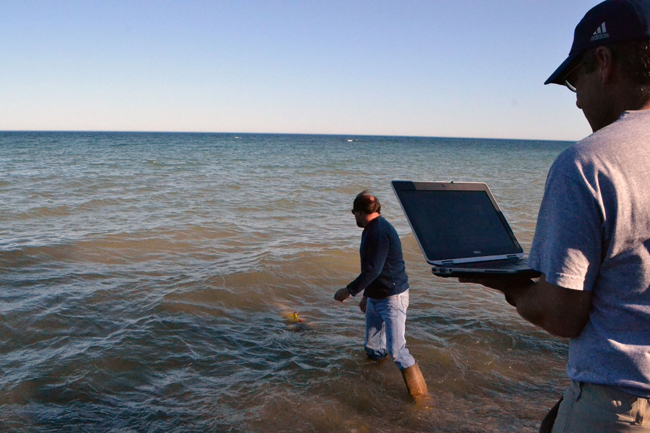
Mike Satchwell from SUNY-ESF launches a research vehicle into Lake Ontario as Russ Miller from the University of Michigan looks on. Photo: Ryan Delaney / WRVO
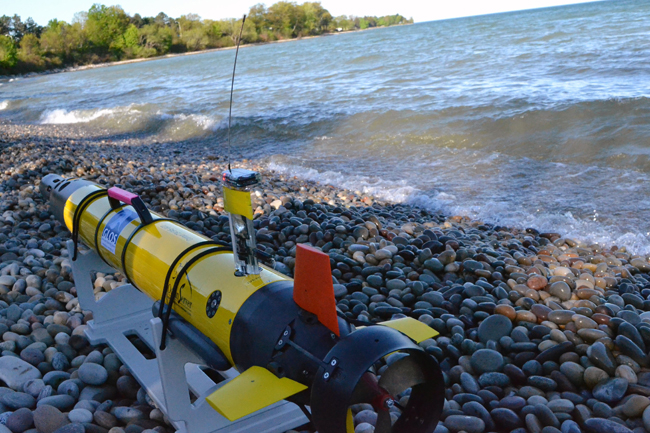
The autonomous research vehicle is about five feet long and is steered by pre-programed GPS coordinates. Photo: Ryan Delaney / WRVO
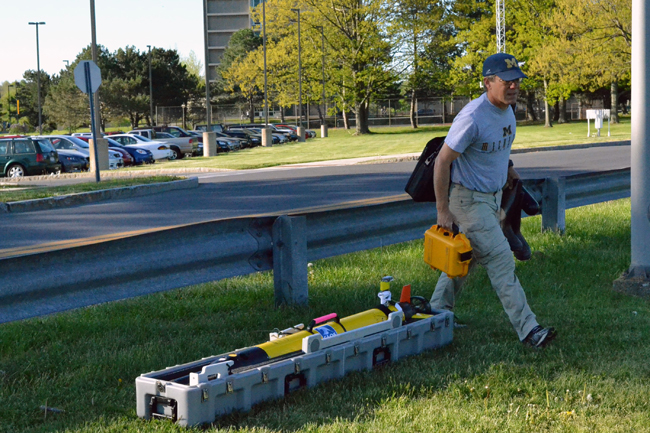
Russ Miller prepares to launch his autonomous research vehicle into Lake Ontario. Photo: Ryan Delaney / WRVO
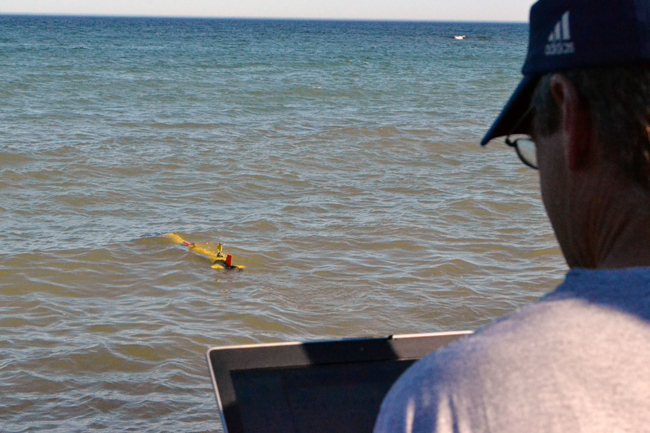
Russ Miller from the Great Lakes Observing System watches his autonomous research vehicle travel into Lake Ontario. Photo: Ryan Delaney / WRVO
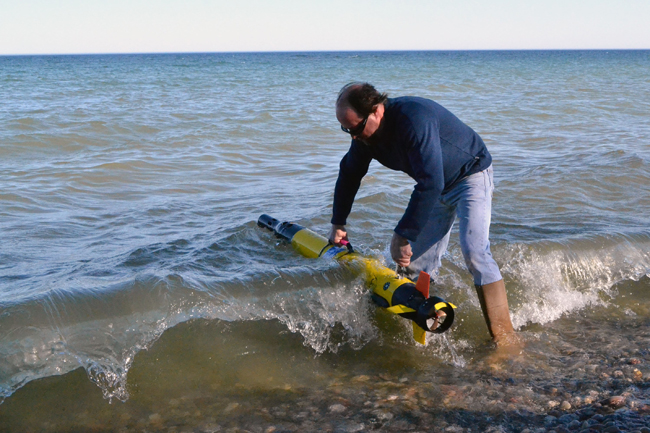
SUNY-ESF support specialist Mike Satchwell launches a research vehicle into Lake Ontario. Photo: Ryan Delaney / WRVO
More Info:
New York Sea Grant (NYSG), a cooperative program of Cornell University
and the State University of New York, is one of 33 university-based
programs under the National Sea Grant College Program (NSGCP) of the
National Oceanic and Atmospheric Administration (NOAA). The NSGCP
engages this network of the nation’s top universities in conducting
scientific research, education, training and extension projects designed
to foster science-based decisions about the use and conservation of our
aquatic resources. Through its statewide network of integrated
services, NYSG has been promoting coastal vitality, environmental
sustainability, and citizen awareness about the State’s marine and Great
Lakes resources since 1971.
For updates on Sea Grant activities: www.nyseagrant.org has RSS, Facebook, Twitter, and YouTube links. NYSG also offers a free e-list sign up via www.nyseagrant.org/coastlines for NY Coastlines, its flagship publication, and Currents, its e-newsletter supplement, each distributed 3-4 times a year.
YNN is one of thirteen 24-hour local news channels owned and operated by
Time Warner Cable nationwide. Content is generated from seven regional
newsrooms. The system has nearly 600,000 subscribers across a 25-county,
15,000 square mile area. YNN Syracuse telecasts one program feed to
Central/Northern NY, one to the Southern Tier. Learn more: www.ynn.com.
Based in Oswego, NY, WRVO Public Media is a part of the National Public
Radio digital network. WRVO broadcasts news on 89.9 FM and HD-2
Oswego/Syracuse; 90.3 FM and HD-2 Syracuse; 91.7 FM and 99.9 Watertown;
90.1 FM Hamilton; 91.9 FM Utica; 90.5 FM Cortland; 90.7 FM Geneva; and
89.9 Norwich. More at www.wrvo.org